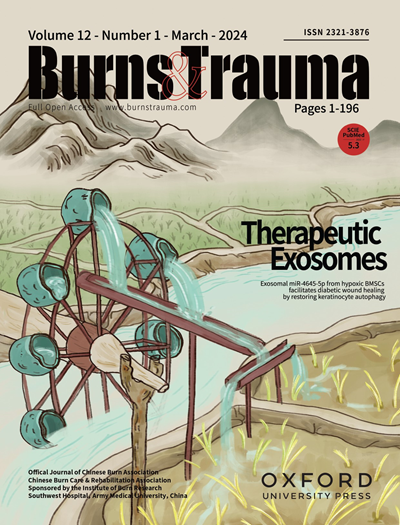Rescuing Endothelial Barrier Dysfunction in Sepsis: miR-23b-3p Antagonizes SMAD3-Mediated EndoMT and Vascular Hyperpermeability
IF 9.6
1区 医学
Q1 DERMATOLOGY
引用次数: 0
Abstract
Background Sepsis-associated acute lung injury (ALI) is driven by endothelial barrier dysfunction and endothelial–mesenchymal transition (EndoMT), mediated by TGF-β1/SMAD3 signaling. Despite the therapeutic potential of SMAD3, current inhibitors face limitations. As endogenous small molecules that are closely related to physiological regulatory processes, miRNAs have more potential research value for regulating SMAD3. Methods Screening multiple databases revealed that miR-23b-3p was the sole miRNA targeting SMAD3. LPS-stimulated HUVECs and cecal ligation/puncture (CLP) mice were used to model sepsis. Lentivirus was used to construct stable strains. The functional performance and mechanism were verified by key techniques, including dual-luciferase assays, rescue experiments, RT–qPCR/Western blotting, monocyte adhesion/permeability assays, and histopathology. Results In LPS-stimulated HUVECs, miR-23b-3p downregulation correlated with TGF-β1/SMAD3 activation, EndoMT progression, and barrier disruption. miR-23b-3p overexpression reversed these effects by restoring the expression of junctional proteins and suppressing the expression of mesenchymal markers. ChIRP-qPCR, RNA-pull-down, and dual-luciferase assays confirmed the direct miR-23b-3p—SMAD3 3’UTR interaction. Rescue experiments demonstrated that miR-23b-3p counteracts TGF-β1/SMAD3 hyperactivation. In CLP mice, intratracheal agomiR-23b-3p attenuated lung injury, normalized alveolar architecture, and reduced vascular leakage by suppressing endothelial Smad3 upregulation. Conclusion miR-23b-3p is a SMAD3-targeting regulator that inhibits EndoMT and repairs endothelial barrier integrity. Mechanistically, miR-23b-3p preserves endothelial homeostasis via SMAD3-dependent EndoMT inhibition. This study provides mechanistic insights and a miRNA-based therapeutic strategy for sepsis-induced ALI.挽救脓毒症中的内皮屏障功能障碍:miR-23b-3p拮抗smad3介导的EndoMT和血管高通透性
脓毒症相关急性肺损伤(ALI)是由内皮屏障功能障碍和内皮-间质转化(EndoMT)驱动,由TGF-β1/SMAD3信号介导。尽管SMAD3具有治疗潜力,但目前的抑制剂面临局限性。mirna作为与生理调控过程密切相关的内源性小分子,对SMAD3的调控具有更大的潜在研究价值。方法筛选多个数据库,发现miR-23b-3p是唯一靶向SMAD3的miRNA。lps刺激huvec和盲肠结扎/穿刺(CLP)小鼠建立脓毒症模型。用慢病毒构建稳定菌株。通过双荧光素酶测定、救援实验、RT-qPCR /Western blotting、单核细胞粘附/通透性测定和组织病理学等关键技术验证其功能性能和机制。结果在lps刺激的HUVECs中,miR-23b-3p下调与TGF-β1/SMAD3激活、EndoMT进展和屏障破坏相关。miR-23b-3p过表达通过恢复连接蛋白的表达和抑制间充质标记物的表达来逆转这些作用。ChIRP-qPCR、RNA-pull-down和双荧光素酶检测证实了miR-23b-3p-SMAD3 3'UTR的直接相互作用。抢救实验表明,miR-23b-3p可抵消TGF-β1/SMAD3的过度激活。在CLP小鼠中,气管内agomiR-23b-3p通过抑制内皮细胞Smad3的上调,减轻了肺损伤,使肺泡结构正常化,并减少了血管泄漏。结论miR-23b-3p是一种smad3靶向调节剂,可抑制EndoMT并修复内皮屏障完整性。在机制上,miR-23b-3p通过smad3依赖性EndoMT抑制维持内皮稳态。这项研究为败血症引起的ALI提供了机制见解和基于mirna的治疗策略。
本文章由计算机程序翻译,如有差异,请以英文原文为准。
求助全文
约1分钟内获得全文
求助全文
来源期刊

Burns & Trauma
医学-皮肤病学
CiteScore
8.40
自引率
9.40%
发文量
186
审稿时长
6 weeks
期刊介绍:
The first open access journal in the field of burns and trauma injury in the Asia-Pacific region, Burns & Trauma publishes the latest developments in basic, clinical and translational research in the field. With a special focus on prevention, clinical treatment and basic research, the journal welcomes submissions in various aspects of biomaterials, tissue engineering, stem cells, critical care, immunobiology, skin transplantation, and the prevention and regeneration of burns and trauma injuries. With an expert Editorial Board and a team of dedicated scientific editors, the journal enjoys a large readership and is supported by Southwest Hospital, which covers authors'' article processing charges.
 求助内容:
求助内容: 应助结果提醒方式:
应助结果提醒方式:


